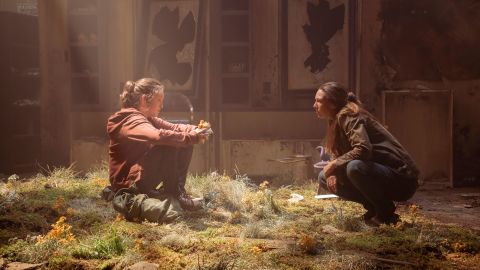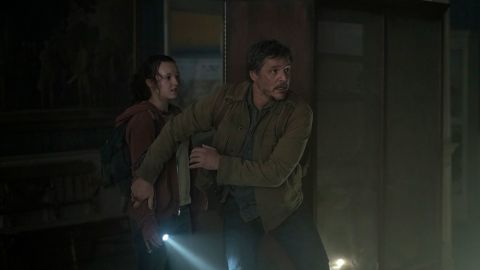CNN
—
By 2013, the zombie apocalypse genre had been done to death. “The Walking Dead” had concluded its third season, “World War Z” was expected to be a summer blockbuster and “Resident Evil” was still perhaps the best-known zombie-starring video game. Where else could the undead go from there?
Enter a little game called “The Last of Us.” The PlayStation 3 exclusive almost immediately became a hit among gamers and critics alike for its powerful storytelling and a unique take on zombies – in the game, they’re humans infected and disfigured by the Cordyceps fungus. This was no ordinary end-of-the-world tale, as evidenced by the intense devotion fans developed for its protagonists, the hardened Joel and young, foul-mouthed Ellie, as they fought for their lives.
“The Last of Us” is now widely recognized as one of the best video games of all time. Ten years after its release, the team behind the game is attempting to make a TV version the best video game adaptation of all time, too. The bar for video game adaptations is fairly low, given the abundance of disappointments and duds made in the past. But the expectations for HBO’s take on “The Last of Us” are high – and the critical reception so far indicates that the series may live up to those expectations.
Fans are eager to return to the post-apocalyptic American wasteland with their favorite morally ambiguous duo. From its heart-wrenching story to its celebrated cast, here’s why fans of the game and prospective new viewers can’t wait to watch “The Last of Us” when it debuts Sunday night. (HBO and CNN share parent company Warner Bros. Discovery.)
If there’s often a divide between gamers and critics, “The Last of Us” was the rare game that satisfied both. The game, originally a PlayStation 3 exclusive, won near-unanimous acclaim when it debuted in 2013, with early reviews calling it the best game of the year and, potentially, one of the greatest of all time.
Recent retrospective reviews of the game and its remake are even more emphatic about the game’s achievements: Inverse said “The Last of Us” was as “close to perfection as it gets,” and Rolling Stone also called it “one of the best games” of its era and a “brutal masterpiece.”
Part of its appeal is what it shares with countless other games: It’s violent and horror-heavy, set in a post-apocalyptic wasteland. But “The Last of Us” also always prioritized the relationship between Joel and Ellie. (In its original 2013 interview, IGN called their rapport “one of the great highlights” of the game.) He’s an often relentless smuggler with a deep-buried paternal side; she’s a parentless teen with the mouth of a sailor and a dangerous secret. Together, they embark across what’s left of the US to maybe save the world, even if at least one of them thinks it’s a futile mission. Predictably, they become something like family.
What’s so unpredictable about “The Last of Us” is how deftly it balances engaging gameplay with compelling, often heartbreaking storytelling. Even its monsters are sympathetic: “The Last of Us does a phenomenal job of making each and every enemy feel human,” IGN wrote in 2013. “Every life taken has weight and each target feels unique and alive.”
And so it’s lived on and grown since its 2013 release – it’s been remade for newer consoles and remastered with updated visuals. Its sequel might even trump the original in terms of emotional devastation (no spoilers here – the HBO adaptation’s creators said if they’re granted a second season, they’ll likely base it on “The Last of Us Part II”). And now, it’s growing again for TV, with an expanded world and lore.
Diehard “Last of Us” fans will be relieved to know that the game’s creator, Neil Druckmann of the game production company Naughty Dog, is credited as the series’ co-creator alongside Craig Mazin, who made HBO’s bleak “Chernobyl” miniseries. In nearly every interview they’ve given ahead of the series’ premiere, they’ve repeated how committed they are to making “The Last of Us” the best adaptation of a video game ever (apologies, “Sonic the Hedgehog”) by avoiding the mistakes of predecessors like “Assassin’s Creed,” whose story was too dense for audiences unfamiliar with the game.

With such high expectations, casting had to be perfect. On its face, it seems like the series comes pretty close, with acclaimed actor Pedro Pascal (the titular “Mandalorian,” “Narcos,” “Game of Thrones”) as Joel and breakthrough performer Bella Ramsey (also of “Game of Thrones,” “Catherine Called Birdy”) as Ellie. The original voices of Joel and Ellie, Troy Baker and Ashley Johnson, also appear in the series in different roles, and Merle Dandridge, who played Marlene in the game, reprises her role here. Gabriel Luna (“Marvel’s Agents of S.H.I.E.L.D.”), Nick Offerman (“Parks and Recreation”), Murray Bartlett (“The White Lotus”) and Anna Torv (“Fringe”) also play pivotal roles.
HBO must believe in the series as much as Mazin and Druckmann do, because it’s taking over the prime 9 p.m. Sunday slot previously occupied by “Game of Thrones” and its prequel, “House of the Dragon,” as well as prestige series like “Succession” and “The White Lotus.” Those series all went on to earn accolades – most recently Golden Globes for “House of the Dragon” and “The White Lotus.”
“The Last of Us” doesn’t necessarily reinvent the post-apocalyptic genre, but “The Walking Dead,” this is not. Compared to the game, little of the series is devoted to grisly kills or relentless gore – the violence is mostly emotional. That might rattle “The Last of Us” players used to destroying fungus-faced monsters between cutscenes, though there are still scares.

The pace is brisk – there’s a whole game to cover – but the series still makes time for occasional digression from the central plot. Visually, “The Last of Us” looks like most every well-known apocalypse story: There are the standard crumbling cityscapes and intruding greenery we’re used to seeing in such shows. More than a few scenes will recall the rugged beauty of “Station Eleven,” another post-apocalyptic series that aired on HBO Max, though “The Last of Us” is less optimistic about the survival and basic goodness of humanity than the former series was.
Oh, and sensitive viewers, beware – “The Last of Us” can be deeply sad. It’s not a punishing watch, but as with any story set at the end of the world, expect a lot of loss.
There’s no pleasing all the fans of a beloved franchise, but HBO’s “The Last of Us” doesn’t necessarily take major departures from the main story gamers have played again and again. Joel and Ellie are still our protagonists, and most of the series is dedicated to their relationship (albeit with some attacks by fungus-monster-people interspersed). The supporting characters from the game – Tess, Marlene, Bill – are brought to vivid life on screen, and viewers have more time than game players did to spend time with these survivors.

But there’s at least one major departure from the game’s plot in an early episode of the series, as a pivotal character’s arc is taken in a drastically different direction on screen that we won’t spoil here. There are some characters original to the series, including a grizzled survivor played by Melanie Lynskey. Oh, and the series’ monsters no longer infect victims with “spores,” a change that might upset some game purists.
Otherwise, so much of the series looks and feels like a love letter to fans – some of the lines, camera angles and stagings are nearly identical to famous scenes from the game. The lay audience may not recognize these similarities, but they’ll certainly delight the fans who’ve played these moments.
“The Last of Us” premieres Sunday at 9 p.m. ET on HBO.